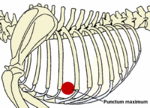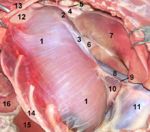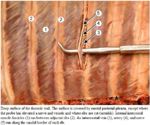Difference between revisions of "Ribs and Sternum - Anatomy & Physiology"
Jump to navigation
Jump to search
Fiorecastro (talk | contribs) |
|||
| (21 intermediate revisions by 8 users not shown) | |||
| Line 1: | Line 1: | ||
| − | {{ | + | {{toplink |
| − | + | |backcolour =CDE472 | |
| + | |linkpage =Musculoskeletal System - Anatomy & Physiology | ||
| + | |linktext =Musculoskeletal System | ||
| + | |maplink = Musculoskeletal System (Content Map) - Anatomy & Physiology | ||
| + | |pagetype =Anatomy | ||
| + | }} | ||
| + | <br> | ||
| + | =Costae= | ||
[[Image:Thorax skeleton.png|thumb|right|150px|Canine thorax showing placement of mitral valve - Wikimedia Commons 2008]] | [[Image:Thorax skeleton.png|thumb|right|150px|Canine thorax showing placement of mitral valve - Wikimedia Commons 2008]] | ||
| − | + | *Arranged in pairs and articulate with two successive vertebrae | |
| − | + | *Bony dorsal part, body of rib, and ventral costal cartilage | |
| − | + | *Increase in length, curvature and amount of cartilage craniocaudally | |
| − | + | *Cartilage of last rib may fail to join that of its neighbor: said to be '''floating''' | |
| − | + | *Join ventrally on the midline at the '''Sternum''', which is comprised of three parts | |
| − | + | **'''Manubrium''': most cranial, projects beyond the first set of ribs and can be palpated | |
| + | **Body: segmented '''sternebrae''' joined by cartilage in young animals that is later replaced by bone | ||
| + | **'''Xiphoid Cartilage''': caudal end that projects between lower ends of costal arches, providing attachment for the '''linea alba''' | ||
| + | *Costal Joints: | ||
| + | **Costovertebral joint: head of rib articulates with vertebral column, ball and socket with very restricted mobility | ||
| + | **Costotransverse joint: tubercle articulates with vertebra, sliding joint | ||
| + | **Costosternal joints: | ||
| + | ***Interchondral joints: asternal ribs, elastic syndesmoses | ||
| + | ***Intersternal joints: impermanent synchondroses | ||
| − | + | =Thoracic Musculature= | |
[[Image: Cat diaphragm.jpg|thumb|right|150px|Cat diaphragm- Copyright Uwe Gille]] | [[Image: Cat diaphragm.jpg|thumb|right|150px|Cat diaphragm- Copyright Uwe Gille]] | ||
| − | + | *Primarily concerned with respiration | |
| + | **Inspiratory muscles enlarge the thoracic cavity | ||
| + | **Expiratory muscles diminish the cavity and force air out | ||
| + | *The most important thoracic muscle is the '''''Diaphragm''''', which separates the thoracic and abdominal cavities | ||
| + | |||
| + | *''Intercostal muscles'' | ||
| + | **Dome-shaped, convex on its cranial surface | ||
| + | **Central tendon forms the vertex | ||
| + | ***Neutral position (between full inspiration and full expiration): 6th rib behind the '''olecranon''' | ||
| + | **Attaches via muscular periphery to the costal arch | ||
[[Image: Intercostal.JPG|thumb|right|150px|Intercostal muscles with nerve and vessels- Copyright C. Clarkson and T.F. Fletcher, University of Minnesota]] | [[Image: Intercostal.JPG|thumb|right|150px|Intercostal muscles with nerve and vessels- Copyright C. Clarkson and T.F. Fletcher, University of Minnesota]] | ||
| − | + | **Three openings: | |
| − | + | ***'''Aortic hilus''' conveying the aorta, azygous vien, and thoracic duct | |
| − | + | ***'''Oesophageal hiatus''' conveying the oesophagus, vagal trunks and supplying vessels | |
| − | + | ***'''Caval foramen''' within central tendon conveying [[Liver - Anatomy & Physiology#Vasculature|caudal vena cava]] | |
| − | + | **Innervated by the '''phrenic nerve''', which arises from the caudal cervical nerves (C5-C7) | |
| − | |||
| − | |||
| − | |||
| − | |||
| − | |||
| − | |||
| − | + | **External fibers run caudoventrally and internal fibers run cranioventrally | |
| − | + | **Each is confined to a single intercostal space | |
| − | + | *''Transversus thoracis'' arises from and covers the dorsal sternum and inserts on sternal ribs close to the costochondral junctions | |
| − | + | *''Rectus thoracis'' covers the ends of the first four ribs in continuation of the ''rectus abdominus'' | |
| + | *''Serratus dorsalis'' overlies the dorsal aspect of the ribs | ||
| + | *Innervation of these muscles is supplied by the '''Intercostal nerves''', which are ventral branches of the thoracic spinal nerves | ||
| + | =Abdominal Musculature= | ||
| + | *Ventrolateral Muscles: flanks and abdominal floor | ||
| + | **All muscles join via aponeuroses in the '''linea alba''' at midline, which runs from the [[Ribs and Sternum - Anatomy & Physiology#Costae|xiphoid process]] to the [[Pelvis - Anatomy & Physiology#Pelvic Girdle|pelvic symphysis]] via the prepubic tendon, ensheathing the ''rectus abdominus'' | ||
| + | **The ''External abdominal oblique'' runs caudoventrally from the lateral surface of the ribs and the lumbar fascia to the linea alba | ||
| + | **The ''Internal abdominal oblique'' runs cranioventrally from the tuber coxae and the thoracolumbar fascia to the linea alba | ||
| + | **The ''Transversus abdominus'' is the deepest muscle of the flank, running dorsoventrally from the inner surface of the last ribs and the transverse processes of the lumbar vertebrae | ||
| + | **The ''Rectus abdominus'' forms a broad band parallel to the linea alba, arising from the ventral costal cartilages and inserting on the prepubic tendon | ||
| + | *Sublumbar Muscles: | ||
| + | **''Psoas minor'': stabilizer of the vertebral column, may also rotate the pelvis at the sacroiliac joint | ||
| + | **''Psoas major'' and ''Iliacus'': | ||
| − | = | + | =Video Links= |
| − | + | *[http://stream2.rvc.ac.uk/Frean/Pony/abdominal_layers.wmv Abdominal Musculature, Pony Dissection, Copyright RVC 2008] | |
| − | + | *[http://stream2.rvc.ac.uk/Frean/sheep/AbdominalWall.wmv Abdominal Wall, Sheep Dissection, Copyright RVC 2008] | |
| − | [ | ||
Revision as of 12:36, 3 September 2008
|
|
Costae
- Arranged in pairs and articulate with two successive vertebrae
- Bony dorsal part, body of rib, and ventral costal cartilage
- Increase in length, curvature and amount of cartilage craniocaudally
- Cartilage of last rib may fail to join that of its neighbor: said to be floating
- Join ventrally on the midline at the Sternum, which is comprised of three parts
- Manubrium: most cranial, projects beyond the first set of ribs and can be palpated
- Body: segmented sternebrae joined by cartilage in young animals that is later replaced by bone
- Xiphoid Cartilage: caudal end that projects between lower ends of costal arches, providing attachment for the linea alba
- Costal Joints:
- Costovertebral joint: head of rib articulates with vertebral column, ball and socket with very restricted mobility
- Costotransverse joint: tubercle articulates with vertebra, sliding joint
- Costosternal joints:
- Interchondral joints: asternal ribs, elastic syndesmoses
- Intersternal joints: impermanent synchondroses
Thoracic Musculature
- Primarily concerned with respiration
- Inspiratory muscles enlarge the thoracic cavity
- Expiratory muscles diminish the cavity and force air out
- The most important thoracic muscle is the Diaphragm, which separates the thoracic and abdominal cavities
- Intercostal muscles
- Dome-shaped, convex on its cranial surface
- Central tendon forms the vertex
- Neutral position (between full inspiration and full expiration): 6th rib behind the olecranon
- Attaches via muscular periphery to the costal arch
- Three openings:
- Aortic hilus conveying the aorta, azygous vien, and thoracic duct
- Oesophageal hiatus conveying the oesophagus, vagal trunks and supplying vessels
- Caval foramen within central tendon conveying caudal vena cava
- Innervated by the phrenic nerve, which arises from the caudal cervical nerves (C5-C7)
- Three openings:
- External fibers run caudoventrally and internal fibers run cranioventrally
- Each is confined to a single intercostal space
- Transversus thoracis arises from and covers the dorsal sternum and inserts on sternal ribs close to the costochondral junctions
- Rectus thoracis covers the ends of the first four ribs in continuation of the rectus abdominus
- Serratus dorsalis overlies the dorsal aspect of the ribs
- Innervation of these muscles is supplied by the Intercostal nerves, which are ventral branches of the thoracic spinal nerves
Abdominal Musculature
- Ventrolateral Muscles: flanks and abdominal floor
- All muscles join via aponeuroses in the linea alba at midline, which runs from the xiphoid process to the pelvic symphysis via the prepubic tendon, ensheathing the rectus abdominus
- The External abdominal oblique runs caudoventrally from the lateral surface of the ribs and the lumbar fascia to the linea alba
- The Internal abdominal oblique runs cranioventrally from the tuber coxae and the thoracolumbar fascia to the linea alba
- The Transversus abdominus is the deepest muscle of the flank, running dorsoventrally from the inner surface of the last ribs and the transverse processes of the lumbar vertebrae
- The Rectus abdominus forms a broad band parallel to the linea alba, arising from the ventral costal cartilages and inserting on the prepubic tendon
- Sublumbar Muscles:
- Psoas minor: stabilizer of the vertebral column, may also rotate the pelvis at the sacroiliac joint
- Psoas major and Iliacus:


